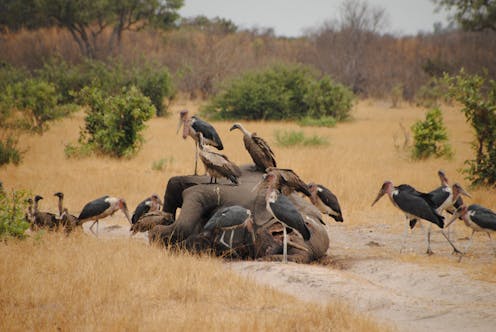
Antibacterial discovery has become a pressing global challenge. Rising antibiotic resistance and difficult-to-treat infections mean we urgently need new antibacterial drugs and infection prevention measures. Food production problems such as bacterial crop disease and food spoilage are driving demand for innovations too.
Authors
Tim Cushnie
Lecturer, Medical and Health Science Programmes, Mahasarakham University
Darren Sexton
Associate Professor in Immunology, Liverpool John Moores University
Vijitra Luang-In
Associate Professor of Biotechnology, Mahasarakham University
Many antibacterial products in current use come from nature, two examples being the antibiotic streptomycin and the food preservative lysozyme. Scientists think antibacterial production evolved for self-defence, helping small organisms repel competitors and large organisms avoid infection. In small organisms inhabiting a larger one, for example friendly gut microbes, antibacterial molecules may serve both of these functions.
This inspired us to consider scavengers such as vultures, hagfish and blowflies. Scavengers feed on decomposing animal carcasses or carrion, a diet you might expect to contain disease-causing bacteria. We were curious if this expectation is supported by scientific data. We also wanted to know if scavengers or their gut microbes have evolved any special defences. And if, like streptomycin or lysozyme, these defences could be developed for human use.
Our study, published in Critical Reviews in Biotechnology, set out to answer these questions. We began by cataloguing the diets of over 600 species of scavenger animals, then cross-referenced this information with current scientific research on infectious disease, immunology and biotechnology.
Exposure to disease-causing bacteria
We identified three factors that make carrion a high-risk food. First, some animal carcasses enter the food chain due to bacterial disease. Animals succumb to many types of infection and can harbour anthrax-, plague- and other disease-causing bacteria after death.
Animals that die from noninfectious causes also pose a risk because botulism-causing bacteria, dormant in the soil and seabed, can colonise their carcasses.
Contact with fellow scavengers represents yet another risk as some, for example feral pigs, blow flies and muscid flies, carry mycobacteria, salmonellae and other infectious bacteria. Interactions between scavengers are likely during feeding, especially when a carcass is large.
Scavenger defences
Our review found that scavengers have multiple antibacterial defences. At a basic level, these include risk-reduction behaviour. For example, turkey vultures and stone crabs avoid particularly rotten carrion. Wolves avoid carrion that's been sitting in the warm summer sun. And common ravens prefer predator-killed animals to those that have died from unknown causes.
The physiological defences scavengers have evolved are even more interesting. For example, wolves hold food in their stomachs for up to 12 hours, twice as long as humans. This gives their stomach acid longer to kill bacteria before they reach the gut. In dermestid beetles and other insects, the gut is protected by a special lining made from the antibacterial material chitin.
Surveillance is another important aspect of defence. And new molecules specialising in bacterial recognition have been discovered in the immune systems of vultures, muscid flies and black soldier flies. These molecules differ structurally from those identified in other animals and often outnumber the bacterial recognition molecules in non-scavenging animals.
New chemical defences have been discovered in scavengers too. These are molecules of different size and structure that inhibit or kill invading bacteria. For example, blow flies produce antimicrobial peptides (AMPs), lipids and proteins that protect their outer surface and circulatory system. Also, friendly microbes in griffon vultures and common sexton beetles produce antibacterial molecules called bacteriocins and cyclic lipopeptides that protect their host's gut.
Antibacterial product development
Some of the above defences, by virtue of their ability to recognise or damage bacteria, may offer opportunities for product development. This type of research has already begun in Germany, China, the USA and other countries.
Small and medium-sized molecules that inhibit or kill bacteria, for example cyclic lipopeptides and AMPs, could potentially be developed as antibacterial drugs. Of particular interest are AMPs that are active against biofilms. Biofilms are sticky layers of bacteria that infect heart valves and joint replacements and are very difficult to treat.
Larger molecules called lectins are good at recognising bacteria and could be useful in drug delivery systems to guide treatments to sites of infection. Also, chitin and other molecules are being studied as antibacterial construction materials for burn dressings and medical implants. Chitin can be obtained from various organisms, but black soldier flies hold promise as a new eco-friendly source.
In agriculture, scavenger-sourced molecules may offer an alternative to antibiotics in animal feed. For example, the antimicrobial lipid lauric acid inhibits disease-causing bacteria in poultry and promotes animal growth and immunity. Antimicrobial lipids work differently to antibiotics and are less likely to generate resistance.
Scientists are also investigating scavenger AMPs as a way to improve disease resistance in food crops. And bacteriocins are being tested for possible use as food preservatives. With the world's population due to exceed 10 billion by 2100, studies like these are needed to increase food security.
Hope for the future
Our review shows that scavengers encounter lots of dangerous bacteria through their diet and dining companions, and have marshalled many defences to protect themselves.
Efforts to develop these defences into new antibacterial products have already begun. And, with over 90% of scavenger species still unstudied or understudied, it is likely that additional useful defences remain to be found.
Contrary to their reputation as "harbingers of death", we think scavengers could help breathe new life into the challenging field of antibacterial discovery.
![]()
The authors do not work for, consult, own shares in or receive funding from any company or organisation that would benefit from this article, and have disclosed no relevant affiliations beyond their academic appointment.






